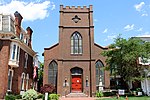Commonwealth Foundation for Public Policy Alternatives
1987 establishments in PennsylvaniaConservative organizations in the United StatesGovernment of PennsylvaniaLibertarian organizations based in the United StatesLibertarian think tanks ... and 4 more
Non-profit organizations based in PennsylvaniaOrganizations based in Harrisburg, PennsylvaniaOrganizations established in 1987Political and economic think tanks in the United States
The Commonwealth Foundation for Public Policy Alternatives is a think tank based in Harrisburg, Pennsylvania. It develops and advances fiscally conservative and libertarian public policies. The organization's stated mission is to "transform free-market ideas into public policies so all Pennsylvanians can flourish."
Excerpt from the Wikipedia article Commonwealth Foundation for Public Policy Alternatives (License: CC BY-SA 3.0, Authors).Commonwealth Foundation for Public Policy Alternatives
State Street, Harrisburg
Geographical coordinates (GPS) Address Nearby Places Show on map
Geographical coordinates (GPS)
| Latitude | Longitude |
|---|---|
| N 40.2634 ° | E -76.8856 ° |
Address
State Street 229
17101 Harrisburg
Pennsylvania, United States
Open on Google Maps










